Question
The production of gametes by the parents, formation of zygote, the $F_1$ and $F_2$ plants, can be understood from a diagram called [NEET 2021]
(a) Bullet square
(b) Punch square
(c) Punnett square
(d) Net squ are
Answer/Explanation
Ans. (c)
Punnett square is a tool that helps to show all possible allelic combinations of gametes in a cross of parents with known genotypes in order to predict the probability of their offspring possessing certain sets of alleles. For a cross involving two genes, a Punnett square is still a good strategy.
Question
The number of contrasting characters studied by Mendel for his experiments was [NEET (Oct.) 2020]
(a) 14
(b) 4
(c) 2
(d) 7
Answer/Explanation
Ans. (d)
Mendel conducted breeding experiments on garden pea by selecting seven pairs of contrasting characters. Luckily all these characters were related as dominant and recessive and none of them showed linakge. The seven pairs of contrasting characters in pea plant were Characters of pea plant.
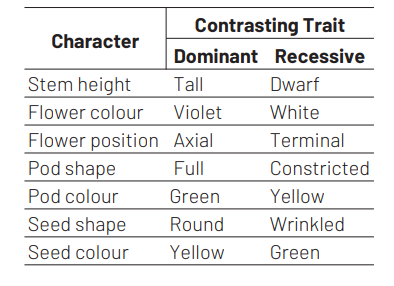
Question
How many true breeding pea plant varieties did Mendel select as pairs, which were similar except in one character with contrasting traits? [NEET (Sep.) 2020]
(a) 2
(b) 14
(c) 8
(d) 4
Answer/Explanation
Ans. (b)
Mendel (father of genetics) selected 14 true-breeding pea plant varieties, in pairs, which were similar except for one character with contrasting traits. A true breeding line refers to the plant that has undergone continuous self-pollination and showed stable trait inheritance and expression for several generations.
Question
Identify the wrong statement with reference to the gene ‘I’ that controls ABO blood groups. [NEET (Sep.) 2020]
(a) A person will have only two of the three alleles
(b) When $\left.\right|^A$ and $\left.\right|^B$ are present together, they express same type of sugar
(c) Allele’i’ does not produce any sugar
(d) The gene (I) has three alleles
Answer/Explanation
Ans. (b)
When $I^A$ and $I^B$ are present together, they express same type of sugar is wrong statement with reference to the gene ‘I’ that controls $A B O$ blood group because $I^A$ and $I^B$ are completely dominant over $I^0$. but when $I^A$ and $I^B$ are present together, they both express their own types of sugar and thus behaving as codominant alleles.
Question
The production of gametes by the parents, the formation of zygotes, the $\mathrm{F}_1$ and $\mathrm{F}_2$ plants, can be understood using [NEET (Odisha) 2019]
(a) pie diagram
(b) a pyramid diagram
(c) Punnett square
(d) Venn diagram
Answer/Explanation
Ans. (c)
The production of gametes by the parents, the formation of zygotes, the $F_1$ and $F_2$ plants can be understood from a diagram called Punnett square. It was developed by a British geneticist, Reginald C. Punnett. It is a graphical representation to calculate the probability of all possible genotypes of offspring in a genetic cross.
Question
In a marriage between male with blood group $A$ and female with blood group B, the progeny had either blood group $A B$ or B. What could be the possible genotype of parents? [NEET (Odisha) 2019]
(a) $I_i$ (Male) $:\left.{ }^B\right|^B$ (Female)
(b) $\mid{ }^A A^A$ (Male) $:\left.I^B\right|^B$ (Female)
(c) $\left.I^A\right|^A$ (Male): ${ }^B i$ (Female)
(d) $A_i A_i$ (Male) : $I^B$ i(Female)
Answer/Explanation
Ans. (a)
The possible genotype of parents having progeny with either blood group $A B$ or $B$ is $1^A{ }^A$ (male): $\left.\left.\right|^B\right|^B$ (female)
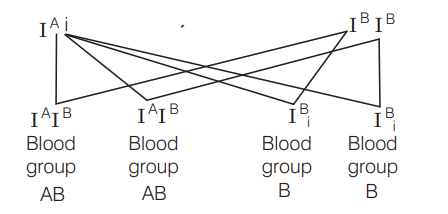
Question
In Antirrhinum (Snapdragon), a red flower was crossed with a white flower and in $\mathrm{F}_1$-generation, pink flowers were obtained. When pink flowers were selfed, the $\mathrm{F}_2$-generation showed white, red and pink flowers.Choose the incorrect statement from the following [NEET (National) 2019]
(a) Pink colour in $F_1$ is due to incomplete dominance
(b) Ratio of $F_2$ is $\frac{1}{4}$ (Red): $\frac{2}{4}$ (Pink): $\frac{1}{4}$ (White)
(c) Law of segregation does not apply in this experiment
(d) This experiment does not follow the principle of dominance
Answer/Explanation
Ans. (c)
The statement that ‘law of segregation does not apply in this experiment is incorrect because the law of segregation applies universally. The reappearence of parental (red and white) flowers in the $\mathrm{F}_2$-generation also confirms, that law of segregation applies in this experiment. Rest statements are correct.
Question
A gene locus has two alleles $A, a$. If the frequency of dominant allele $A$ is $0.4$, then what will be the frequency of homozygous dominant, heterozygous and homozygous recessive individuals in the population? [NEET (National) 2019]
(a) $0.16(\mathrm{AA}) ; 0.24(\mathrm{Aa}) ; 0.36$ (aa)
(b) $0.16(\mathrm{AA}) ; 0.48(\mathrm{Aa}) ; 0.36$ (aa)
(c) $0.16(\mathrm{AA}): 0.36(\mathrm{Aa}) ; 0.48$ (aa)
(d) $0.36$ (AA); $0.48$ (Aa); $0.16$ (aa)
Answer/Explanation
Ans. (b)
The frequency of homozygous dominant, heterozygous and homozygous recessive individuals would be $0.16$ (AA); $0.48$ (Aa); $0.36$ (aa). The frequencies are calculated as follows:
Frequency of dominant allele $(p)=0.4$ (given)
Frequency of recessive allele (q) $=1-0.4=0.6$
Frequency of homozygous dominant individuals $(\mathrm{AA})=p^2=(0.4)=0.16$
Frequency of heterozygous individual $(\mathrm{Aa})=2 \mathrm{pq}$ $=2(0.4)(0.6)=0.48$
Frequency of homozygous recessive individual (aa)
$
=\mathrm{q}^2=(0.6)^2=0.36
$
Question
Select the correct statement. [NEET 2018]
(a) Spliceosomes take part in translation
(b) Punnett square was developed by a British scientist
(c) Franklin Stahl coined the term ‘linkage’
(d) Transduction was discovered by S. Altman.
Answer/Explanation
Ans. (b)
Punnett Square is a checker-board used to show the result of a cross between two organisms. The checker board was devised by a British geneticist, Regnald Punnett (1927). It depicts both genotypes and phenotypes of the progeny.
Franklin Stahl with Matthew Meselson proved the semi-conservative replication of DNA. Spliceosome is formed during post-transcriptional changes in eukaryotes. It is a complex, formed between $5^{\prime}$ end (GU) and $3^{\prime}$ end (AG) of intron to remove it.
Transduction is a method of sexual reproduction in bacteria. It involves the transfer of foreign genes by means of viruses. It was discovered by Zinder and his teacher Lederberg $(1952)$ in Salmonella typhimurium.
Question
Which of the following characteristics represents ‘Inheritance of blood groups’ in humans? [NEET 2018]
1. Dominance
2. Codominance
3. Multiple allele
4. Incomplete dominance
5. Polygenic inheritance
(a) 2,4 and 5
(b) 1,2 and 3
(c) 2,3 and 5
(d) 1,3 and 5
Answer/Explanation
Ans. (b)
Dominance, codominance and multiple alleles are the characteristics that represent ‘inheritance of blood groups’ in humans. $\mathrm{ABO}$ blood groups are determined by the gene 1 . There are multi ple (three) alleles; $\mathrm{I}^{\mathrm{A}}, \mathrm{I}^{\mathrm{B}}$ and $\mathrm{I}^0$ of this gene. Allele $\mathrm{I}^{\mathrm{A}}$ and $\mathrm{I}^{\mathrm{B}}$ are dominant over $\mathrm{I}^{\mathrm{O}}$. However, when $\mathrm{I}^{\mathrm{A}}$ and $\mathrm{I}^{\mathrm{B}}$ alleles are present together, they show codominance.
Therefore, option (b) is correct.
Question
Which one from those given below is the period of Mendel’s hybridisation experiments? [NEET 2017]
(a) $1856-1863$
(b) $1840-1850$
(c) $1857-1869$
(d) $1870-1877$
Answer/Explanation
Ans. (a)
Mendel was a great Mathematician and was Austrian Monk. He became interested in genetics and conducted experiments in pea plant (Pisum sativum). He hybridised the contrasting characters of the plant and conducted his experiments for more than 10 years between 1856-1863; this experimental data was published in 1865.
Question
Among the following characters, which one was not considered by Mendel in his experiments on pea? [NEET 2017]
(a) Stem – Tall or Dwarf
(b) Trichomes – Glandular or Non-glandular
(c) Seed – Green or Yellow
(d) Pod – Inflated or Constricted
Answer/Explanation
Ans. (b)
Trichomes are the epidermal tissues structure. When epidermal cells become glandular hair, it is called trichome. This character was not amongst the seven characters of pea, which mendel selected for his hybridisation experiments.
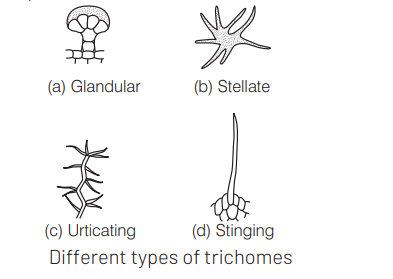
Question
The genotypes of a husband and wife are $\mathrm{I}^{\mathrm{A}} \mathrm{I}^{\mathrm{B}}$ and $\mathrm{I}^{\mathrm{A}} \mathrm{i}$. Among the blood types of their children, how many different genotypes and phenotypes are possible? [NEET 2017]
(a) 3 genotypes ; 3 phenotypes
(b) 3 genotypes ; 4 phenotypes
(c) 4 genotypes ; 3 phenotypes
(d) 4 genotypes ; 4 phenotypes
Answer/Explanation
Ans. (c)
A cross between two individuals, one with $A B$ blood group and other with $A$ blood group will produce four genotypes and three phenotypes.
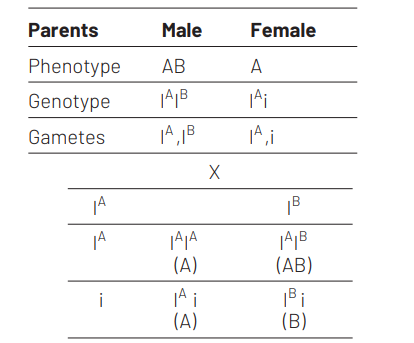
Offsprings Genotypes $4\left(\left.\left.\right|^A\right|^{\mathrm{A}},\left.\left.\right|^{\mathrm{A}}\right|^{\mathrm{B}},\left.\right|^{\mathrm{A}} i,\left.\right|^{\mathrm{B}} i\right)$ Phenotypes $3(A, B, A B)$
Question
A true breeding plant is [NEET 2016, Phase II]
(a) one that is able to breed on its own
(b) produced due to cross-pollination among unrelated plants
(c) near homozygous and produces offspring of its own kind
(d) always homozygous recessive in its genetic constitution
Answer/Explanation
Ans. (c)
A true breeding plant (pureline) has homozygous genes for a character (e.g. TT for tall or tt for dwarf). It always produces offsprings which are true (pure) for its characters.
Question
Match the terms in column I with their description in column II and choose the correct option. [NEET 2016, Phase I]
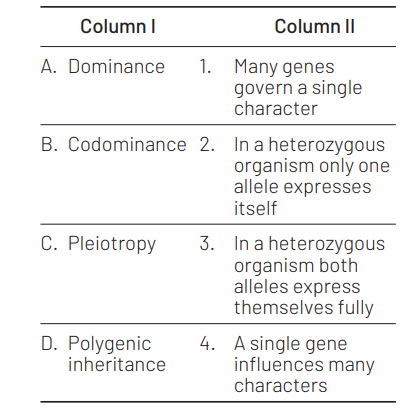
Code
A B C D
(a) 2 3 4 1
(b) 4 1 2 3
(c) 4 3 1 2
(d) 2 1 4 3
Answer/Explanation
Ans. (a)
Dominance-Expression of only one allele in a heterozygous organism.
Codominance-Side by side full expression of both alleles. $F_1$ resembles both parents.
Pleiotropy – Single gene can exhibit multiple phenotypic expression, e.g. Phenylketonuria.
Polygenic inheritance-Many genes govern a single character, e.g. Human skin colour.
Question
A tall true breeding garden pea plant is crossed with a dwarf true breeding garden pea plant. When the $F_1$ plants were selfed the resulting genotypes were in the ratio of [NEET 2016, Phase I]
(a) $1: 2: 1::$ Tall heterozygous : Tall homozygous : Dwarf
(b) $3: 1::$ Tall : Dwarf
(c) $3: 1::$ Dwarf : Tall
(d) 1:2:1:: Tall homozygous : Tall heterozygous: Dwarf
Answer/Explanation
Ans. (d)
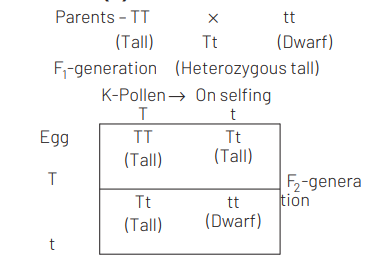
Phenotypic ratio $=3: 1[$ Tall : Dwarf $]$
Genotypic ratio $\Rightarrow 1: 2: 1$
[Homozygous tall : Heterozygous tall : Dwarf]
Question
A gene showing codominance has [CBSE AIPMT 2015]
(a) one allele dominant on the other
(b) alleles tightly linked on the same chromosome
(c) alleles that are recessive to each other
(d) Both alleles independently expressed in the heterozygote
Answer/Explanation
Ans. (d)
A gene shows codominance when both alleles in heterozygous condition, express their traits independently instead of showing dominant-recessive relationship and such alleles are called codominant alleles.
Question
In his classic experiments on pea plants, Mendel did not use [CBSE AIPMT 2015]
(a) seed colour
(b) pod length
(c) seed shape
(d) flower position
Answer/Explanation
Ans. (b)
Pod length was not considered by Mendel in his experiments. For his experiments, Mendel choose seven characters of pea plants which are
1. Seed colour
2. Seed shape
3. Flower colour
4. Pod colour
5. Pod shape
6. Flower position and
7. Plant height
Question
A pleiotropic gene [CBSE AIPMT 2015]
(a) is expressed only in primitive plants
(b) is a gene evolved during Pliocene
(c) controls a trait only in combination with another gene
(d) controls multiple traits in an individual
Answer/Explanation
Ans. (d)
Pleiotropic gene is a gene that controls multiple traits is an individual. It is also called polyphenic gene, e.g. phenylketonuria causing multiple adverse effects due to the mutation in a single gene coding for enzyme phenylalanine hydroxylase.
Question
Fruit colour in squash is an example of [CBSE AIPMT 2014]
(a) recessive epistasis
(b) dominant epistasis
(c)complementary genes
(d) inhibitory genes
Answer/Explanation
Ans. (b)
Fruit colour in squash is an example of dominant epistasis in which the dominant gene (epistatic gene) masks the effect of other gene (recessive hypostatic gene). Squash fruit appear white due to the epistatic effect of $W$ allele (white colour) over ‘G’ allele (green colour).
Question
If two persons with ‘AB’ blood group marry and have sufficiently large number of children, these children could be classified as ‘A’ blood group: ‘AB’ blood group: ‘B’ blood group in $1: 2: 1$ ratio. Modern technique of protein electrophoresis reveals presence of both ‘ $A$ ‘ and ‘ $B$ ‘ type proteins in ‘AB’ blood group individuals. This is an example of [NEET 2013]
(a) codominance
(b) incomplete dominance
(c) partial dominance
(d) complete dominance
Answer/Explanation
Ans. (a)
In codominance both alleles of a pair express themselves fully in $F_1$ hybrid. It is contrary to the situation seen in incomplete dominance, where traits express themselves only partially. This is not the example of partial dominance or complete dominance

Question
Which Mendelian idea is depicted by a cross in which the $\mathrm{F}_1$-generation resembles both the parents? [NEET 2013]
(a) Incomplete dominance
(b) Law of dominance
(c) Inheritance of one gene
(d) Codominance
Answer/Explanation
Ans. (d)
In codominance, both alleles of a pair express themselves fully in $F_f$ hybrid, so, it resembles both the parents. In incomplete dominance, the two genes of allelomorphic pair are not related as dominant or recessive, but each of them express itself partially. Law of dominance states that when a cross is made between two homozygous individuals considering contrasting trait of simple character then the trait that appear in $F_1$ hybrids is called dominant. Inheritance of one gene is based on crossing between single traits.
Question
$ \mathrm{~F}_2$-generation in a Mendelian cross showed that both genotypic and phenotypic ratios are same as 1:2 :1. It represents a case of [CBSE AIPMT 2012]
(a) codominance
(b) dihybrid cross
(c) monohybrid cross with complete dominance
(d) monohybrid cross with incomplete dominance
Answer/Explanation
Ans. (d)
Monohybrid cross with incomplete dominance shows both genotypic and phenotypic ratio as same $(1: 2: 1)$.
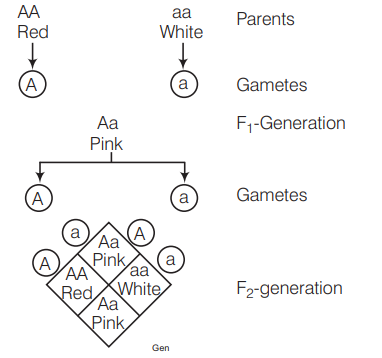
Genotypic ratio -1 (AA) : 2 (Aa) : 1 (aa) Phenotypic ratio – 1(Red): 2 (Pink): 1(white)
Question
$\mathrm{ABO}$ blood groups in humans are controlled by the gene I. It has three alleles $-\mathrm{I}^{\mathrm{A}}, \mathrm{I}^{\mathrm{B}}$ and $\mathrm{i}$. Since there are three different alleles, six different genotypes are possible. How many phenotypes can occur? [CBSE AIPMT 2010]
(a) Three
(b)One
(c) Four
(d) Two
Answer/Explanation
Ans. (c)
The ABO blood group system has at least 6 genotypes. On the basis of presence or absence of antigens and antibodies, four blood groups (phenotypes) have been differentiated- $A, B, A B$ and $O$ blood groups. In $A B O$ blood group system, inheritance of grouping is controlled by a single autosomal gene on chromosome 9 with three major alleles $A, B$ and $O$ ( $I^A, I^B$ and $\left.I^D\right)$.
Question
Which one of the following cannot be explained on the basis of Mendel’s Law of Dominance? [CBSE AIPMT 2010]
(a) The discrete unit controlling a particular character is called a factor
(b) Out of one pair of factors one is dominant, and the other recessive
(c) Alleles do not show any blending and both the characters recover as such in $\mathrm{F}_2$-generation
(d) Factors occur in pairs
Answer/Explanation
Ans. (c)
Out of the following statement (c) is incorrect because the law of dominance does not occur universally. After Mendel several cases were recorded by scientists, where a clear deviation from law of dominance was seen. Such a deviation may be seen in the form of incomplete dominance or blending inheritance and co-dominance.
Where, $F_1$ hybrids exhibited a mixture or blending of character of two parents, the case is considered as that of incomplete dominance or blending inheritance. It simply means that two genes of allelomorphic pair are not related as dominant or recessive, but each of them expresses itself partially. In the case of 4 O’clock plant, when plants with red flowers are crossed with plants having white flower, the $F_1$ hybrids bear pink flower. When these pink flowers are self pollinated, they develop red, pink and white flowers in the ratio of $1: 2: 1$ respectively.
Question
The genotype of a plant showing the dominant phenotype can be determined by [CBSE AIPMT 2010]
(a) test cross
(b) dihybrid cross
(c) pedigree analysis
(d) back cross
Answer/Explanation
Ans. (a)
In genetics, a test cross, first introduced by Gregor $\mathrm{J}$ Mendel, is used to determine if an individual exhibiting a dominant trait is homozygous or heterozygous for that trait. More simply, test cross determines the genotype of an individual with a dominant phenotype. In some sources, the test cross is defined as being a type of back cross between the recessive homozygote and $F_1$-generation.
Question
In pea plants, yellow seeds are dominant to green. If a heterozygous yellow seeded plant is crossed with a green seeded plant, what ratio of yellow and green seeded plants would you expect in $\mathrm{F}_1$-generation? [CBSE AIPMT 2007]
(a) $50: 50$
(b) $9: 1$
(c) $1: 3$
(d) $3: 1$
Answer/Explanation
Ans. (a)
In the given cross the ratio is $50: 50$ of yellow and green seeded plants in $F_1$-generation.
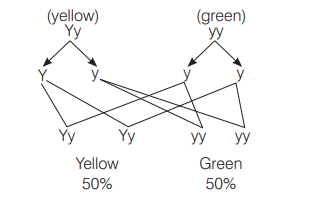
Question
A common test to find the genotype of a hybrid is by [CBSE AIPMT 2007]
(a) crossing of one $\mathrm{F}_2$ progeny with male parent
(b) crossing of one $F_2$ progeny with female parent
(c) studying the sexual behaviour of $\mathrm{F}_1$-progenies
(d) crossing of one $F_1$ progeny with male parent
Answer/Explanation
Ans. (d)
Test cross, i.e. crossing of $F_1$-progeny to the recessive parent is used to find the genotype of the progeny.
Question
A human male produces sperms with the genotypes $A B, A b, a B$ and ab pertaining to two diallelic characters in equal proportions. What is the corresponding genotype of this person? [CBSE AIPMT 2007]
(a) $\mathrm{AaBb}$
(b) $\mathrm{AaBB}$
(c) AABb
(d) AABB
Answer/Explanation
Ans. (a)
The corresponding genotype of person will be $\mathrm{AaBb}$.
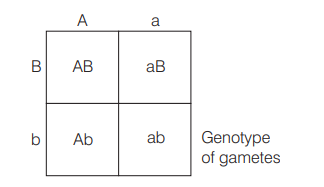
Question
Test cross involves [CBSE AIPMT 2006]
(a) crossing between two genotypes with recessive trait
(b) crossing between two $F_1$ hybrids
(c) crossing the $F_1$ hybrid with a double recessive genotype
(d) crossing between two genotypes with dominant trait.
Answer/Explanation
Ans. (c)
The test cross involves the crossing of $F_l$ hybrid with a double recessive genotypic parent. By test cross, the heterozygosity and homozygosity of the organism can be tested.
Thus, the offspring will be $100 \%$ dominant, if the individual which crossed with recessive parent, i.e. (tt) was homozygous dominant and ratio will be $50 \%$ dominant and $50 \%$ recessive if the individual was heterozygous dominant. In dihybrid test cross, ratio will be 1:1:1:1.
Question
How many different kinds of gametes will be produced by a plant having the genotype AABbCC? [CBSE AIPMT 2006]
(a) Three
(b) Four
(c) Nine
(d) Two
Answer/Explanation
Ans. (d)
The types of gametes produced by a plant depend upon the number of heterozygous pair.
Number of types of gametes $=2^n$
$\mathrm{n}=$ number of heterozygous pair $2^{\dagger}=2$
The gametes are – $\mathrm{ABC}$ and $\mathrm{ABC}$.
Question
In Mendel’s experiments with garden pea, round seed shape (RR) was dominant over wrinkled seeds (rr) yellow cotyledon $(Y Y$ ) was dominant over green cotyledon (yy). What are the expected phenotypes in the $\mathrm{F}_2$-generation of the cross RRYY × rryy ? [CBSE AIPMT 2006]
(a) Only round seeds with green cotyledons
(b)Only wrinkled seeds with yellow cotyledons
(c) Only wrinkled seeds with green cotyledons
(d) Round seeds with yellow cotyledons and wrinkled seeds with yellow cotyledons
Answer/Explanation
Ans. (d)
When a cross (dihybrid) is made between plants bearing round yellow (RRYY) and wrinkled green (rryy) seeds, all the plants in $\mathrm{F}_1$-generation are with yellow round seeds(showing the genotype RrYy). The phenotype in $F_2$ will be as follows
Question
Phenotype of an organism is the result of [CBSE AIPMT 2006]
(a) mutations and linkages
(b) cytoplasmic effects and nutrition
(c) environmental changes and sexual dimorphism
(d) genotype and environmental interactions
Answer/Explanation
Ans. (d)
Phenotype is the observable characteristics or the total appearance of an organism. It is determined by its genes, the relationships between the alleles and by the interaction during development between its genetic constitution (genotype) and the environment.
Question
In order to find out the different types of gametes produced by a pea plant having the genotype $\mathrm{AaBb}$, it should be crossed to a plant with the genotype [CBSE AIPMT 2005]
(a) $\mathrm{aaBB}$
(b) $\mathrm{AaBb}$
(c) $A A B B$
(d) aabb
Answer/Explanation
Ans. (d)
In the given question AaBb should be crossed with aabb. Scientists perform test cross to find out the different types of gametes or the genotype of an unknown individual. Test cross is performed always between the $F_1$ heterozygous plants and pure recessive (homozygous) parent plant. So, in the given case AaBb should be crossed with aabb.
Question
In a plant, red fruit $(R)$ is dominant over yellow fruit ( $r$ ) and tallness $(T)$ is dominant over shortness (t). If a plant with RRTt genotype is crossed with a plant that is rrtt [CBSE AIPMT 2004]
(a) $25 \%$ will be tall with red fruit
(b) $50 \%$ will be tall with red fruit
(c) $75 \%$ will be tall with red fruit
(d) all of the offspring will tall with red fruit
Answer/Explanation
Ans. (a)
In the given experimnet $50 \%$ will be tall with red fruits. It can be explanied as
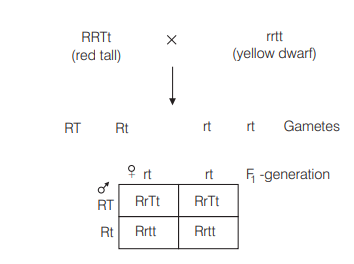
Conclusion :
1. All plants are red.
2. 50% are red tall.
3. 50% are red dwarf.
Question
A male human is heterozygous for autosomal genes $A$ and $B$ and is also hemizygous for haemophilic gene $h$. What proportion of his sperms will be abh? [CBSE AIPMT 2004]
(a) $\frac{1}{8}$
(b) $\frac{1}{32}$
(c) $\frac{1}{16}$
(d) $\frac{1}{4}$
Answer/Explanation
Ans. (a)
The genotype of human male in question must be Aa BbX $X^h Y$.
Hence $2 \times 2 \times 2=8$ types of gametes would be formed. $A B X^h, A B Y, a B X^h$. $a B Y, A b X^h, A b Y, a b X^h, a b Y$.
Hence, $1 / 8$ proportion of his sperms would be abh.
Question
Two crosses between the same pair of genotypes or phenotypes in which the sources of the gametes are reversed in one cross, is known as [CBSE AIPMT 2003]
(a) dihybrid cross
(b) reverse cross
(c) test cross
(d) reciprocal cross
Answer/Explanation
Ans. (d)
Since genotypes/phenotypes of both parents are same-only sources of gametes are reversed, these crosses are called reciprocal crosses.
Question
The genes controlling the seven pea characters studied by Mendel are now known to be located on how many different chromosomes? [CBSE AIPMT 2003]
(a) Five
(b) Four
(c) Seven
(d) Six
Answer/Explanation
Ans. (b)
As a result of studies by $S$ Blixt, it is now known that Menders seven selected characters are located on four chromosomes. Of these, two characters are located on chromosome number 1 . three of chromosome number 4 and one each on chromosome number 5 and 7.
Question
Which one of the following traits of garden pea studied by Mendel was a recessive feature? [CBSE AIPMT 2003]
(a) Green pod colour
(b) Round seed shape
(c) Axial flower position
(d) Green seed colour
Answer/Explanation
Ans. (d)
Green seed colour was a recessive character in Mendel’s experiment. When a pair of contrasting characters are crossed together then $\mathrm{F}_1$-generation has only one type of character. This expressed character is known as dominant character while the character which could not express in $\mathrm{F}_1$-generation is known as recessive character. In pea plants, tallness, round seed, yellow seed, purple flower, green pod, inflated pod and axial flower are dominant over dwarfness, wrinkled seed, green seed, white flower, yellow pod, constricted pod and terminal flower respectively.
Question
A plant of $\mathrm{F}_1$-generation has genotype ‘AABbCC. On selfing of this plant, the phenotypic ratio in $\mathrm{F}_2$-generation will be [CBSE AIPMT 2002]
(a) $3: 1$
(b) $1: 1$
(c) $9: 3: 3: 1$
(d) $27: 9: 9: 9: 3: 3: 3: 1$
Answer/Explanation
Ans. (a)
Since, AABbCC contains only one heterozygous allelic pair’ $B b^{\prime}$ ‘, the cross would behave as monohybrid cross leading to $3: 1$ phenotypic ratio in $\mathrm{F}_2$.
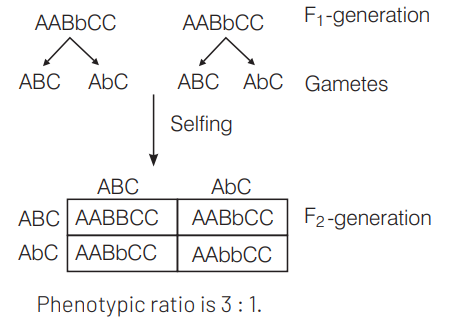
Question
In his experiment, Mendel obtained wrinkled pea. The wrinkling was due to deposition of sugar instead of starch. This happened due to the enzyme [CBSE AIPMT 2001]
(a) amylase
(b) invertase
(c) diastase
(d) absence of starch-branching enzyme
Answer/Explanation
Ans. (d)
In round seeds (RR/Rr) Starch-Branching Enzyme-1(SBE-1) is found but is absent from wrinkled seeds. In rr seeds, a small DNA segment interferes with SBE-1 activity so that starch is not formed and free sugar gets accumulated. Resulting high osmotic pressure in rr seeds leads to shrinkage and wrinkling.
Question
Which of these do not follow independent assortment? [CBSE AIPMT 2001]
(a) Genes on non-homologous chromosomes and absence of linkage
(b) Genes on homologous chromosomes
(c) Linked genes on same chromosome
(d) Unlinked genes on same chromosome
Answer/Explanation
Ans. (c)
Genes which are linked and are situated on same chromosome, cannot ‘separate’ during gametes formation and hence, cannot assort independently.
Question
Two non-allelic genes produce the new phenotype when present together but fail to do so independently, it is called [CBSE AIPMT 2001]
(a) epistasis
(b) polygene
(c) non-complementary gene
(d) complementary gene
Answer/Explanation
Ans. (d)
In complementary genes, two separate pair of genes interact to produce the phenotype in such a way that neither of the dominant genes is expressive unless the other one is absent.
Question
Ratio of complementary genes is [CBSE AIPMT 2001]
(a) $9: 3: 4$
(b) $12: 3: 1$
(c) $9: 3: 3: 4$
(d) $9: 7$
Answer/Explanation
Ans. (d)
In case of complementary genes, the ratio of $9: 7$ is obtained in $F_2$-generation. This was first discovered by Bateson and Punnett. Complementary genes are those genes which express themself when present together. None of these two get expressed yourself when present alone.
Question
Which one of the following characters studied by Mendel in garden pea was found to be dominant? [CBSE AIPMT 2000]
(a) Green seed colour
(b) Terminal flower position
(c) Green pod colour
(d) Wrinkled seed
Answer/Explanation
Ans. (c)
Green pod colour was a dominant. character in Mendel’s garden pea experiment.
Question
Hybridisation between $\mathrm{Tt} \times \mathrm{tt}$ gives rise to the progeny of ratio [CBSE AIPMT 1999]
(a) $1: 1$
(b) $1: 2: 1$
(c) $1: 2$
(d) $4: 1$
Answer/Explanation
Ans. (a)
Offsprings with genotypes Tt (heterozygous tall) and tt (homozygous dwarf) are produced in the ratio of $1: 1$.
Question
How many types of genetically different gametes will be produced by a heterozygous plant having genotype AABbCc? [CBSE AIPMT 1998]
(a) Two
(b) Four
(c) Six
(d) Nine
Answer/Explanation
Ans. (b)
First pair AA is homozygous hence, it will contribute only one type of gene to gametes, Bb will yield two types of gametes-B and $b$ similarly, Cc will yield two types of gametes- $\mathrm{C}$ and c. Hence, $1 \times 2 \times 2=4$ types of gametes would be produced having the genotypes $\mathrm{ABC}, \mathrm{ABC}, \mathrm{AbC}$ and $\mathrm{Abc}$.
Question
If Mendel had studied the seven traits using a plant with 12 chromosomes instead of 14 , in what way would his interpretation have been different? [CBSE AIPMT 1998]
(a) He would have mapped the chromosome
(b) He would have discovered blending or incomplete dominance
(c) He would not have discovered the law of independent assortment
(d) He would have discovered sex-linkage
Answer/Explanation
Ans. (c)
If Mendel would have studied seven traits in 12 chromosomes instead of 14 he would not have discovered independent assortment.
Question
When a single gene influences more than one traits it is called [CBSE AIPMT 1998]
(a) pleiotropy
(b) epistasis
(c) pseudodominance
(d) None of these
Answer/Explanation
Ans. (a)
Pleiotropy is the condition in which a single gene influences more than one traits, e.g. gene for single cell produces anaemia as well as resistance to malaria.
Question
Alleles that produce independent effects in their heterozygous condition are called [CBSE AIPMT 1996]
(a) codominant alleles
(b) epistatic alleles
(c) complementary alleles
(d) supplementary alleles
Answer/Explanation
Ans. (a)
Codominant alleles produce independent effects in their heterozygous condition. Both the genes produce their independent effect.
Question
In a dihybrid cross $A A B B \times a a b b$, $\mathrm{F}_2$ progeny of $A A B B, A A B b, A a B B$ and $A a B b$ occurs in the ratio of [CBSE AIPMT 1994]
(a) $1: 1: 1: 1$
(b) $9: 3: 3: 1$
(c) $1: 2: 2: 1$
(d) $1: 2: 2: 4$
Answer/Explanation
Ans. (d)
In a dihybrid cross the genotypic ratio can be represented as follows-assuming a cross between AABB and aabb
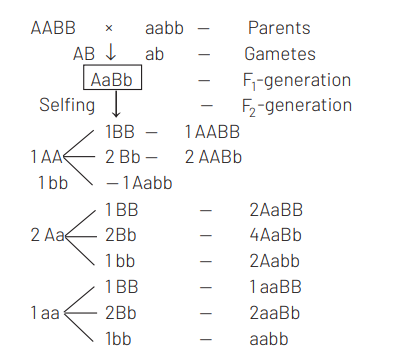
So, the ratio of $A A B B, A A B b, A a B B$ and AaBb will be $1: 2: 2: 4$.
Question
A cross between pure tall pea plant with green pods and dwarf pea plant with yellow pods will produce dwarf $\mathrm{F}_2$ plants out of 16 [CBSE AIPMT 1994]
(a) 9
(b) 3
(c) 4
(d) 1
Answer/Explanation
Ans. (c)
This is an example of dihybrid cross because two characters are being studied simultaneously in which dwarfness is a recessive characters, so in $\mathrm{F}_2$-generation 4 plants will be dwarf out of 16 .
Question
A child of blood group 0 cannot have parents of blood groups [CBSE AIPMT 1994]
(a) $A B$ and $A B / O$
(b) $A$ and $B$
(c) $B$ and $B$
(d) 0 and 0
Answer/Explanation
Ans. (a)
Blood group of the child is determined by allelic genes, i.e. $I^A I^B$ and $I^O$ in which $I^A$ and $I^B$ are dominant over $I^O$, so if one of the parent either mother or father is of blood group $A B$, then she or he will have both genes, i.e $I^A$ and $I^B$ and child of such parent cannot have blood group 0 .
Question
Which of the following is suitable for experiment on linkage? [CBSE AIPMT 1993]
(a) $a a B B \times a a B B$
(b) $A A B B \times a a b b$
(c) $\mathrm{AaBb} \times \mathrm{AaBb}$
(d) AAbb $\times$ AaBB
Answer/Explanation
Ans. (b)
AABB $\times$ aabb is suitable for experiment on linkage. Linkage may be defined as the tendency of two genes of the same chromosome to remain together in the process of inheritance.
Question
Mendel studied inheritance of seven pairs of traits in pea which can have 21 possible combinations. If you are told that in one of these combinations, independent assortment is not observed in later studies, your reaction will be [CBSE AIPMT 1993]
(a) independent assortment principle may be wrong
(b) Mendel might not have studied all the combinations
(c) it is impossible
(d) later studies may be wrong
Answer/Explanation
Ans. (b)
Mendel’s law of independent assortment. is applicable to only those genes which are located on different chromosomes, so if in one of the combination independent assortment is not observed that means Mendel might not have studied all the combinations.
Question
A polygenic inheritance in human beings is [CBSE AIPMT 1993, 99, 2006, 07]
(a) skin colour
(b) phenylketonuria
(c) colour blindness
(d) sickle-cell anaemia
Answer/Explanation
Ans. (a)
Human skin colour is controlled by polygenic effect atleast by three separate genes. Skin colour is determined by cumulative genes and this hypothesis was designed by Devenport and Devenport in 1910.
Question
An organism with two identical alleles is [CBSE AIPMT 1992]
(a) dominant
(b) hybrid
(c) heterozygous
(d) homozygous
Answer/Explanation
Ans. (d)
An organism with two identical alleles is homozygous, e.g. $\mathrm{rr}, \mathrm{tt}, \mathrm{RR}, \mathrm{TT}$, etc.
Question
Segregation of Mendelian factors (no linkage, no crossing over) occurs during [CBSE AIPMT 1992]
(a) anaphase-1
(b) anaphase-II
(c) diplotene
(d) metaphase-1
Answer/Explanation
Ans. (a)
At the end of anaphase-I, two groups of chromosomes (one at each pole) are produced. Each such group is having half the original number of chromosomes present in the parent nucleus. So, anaphase-I results in the reduction of chromosome number to half and segregation of Mendelian factors.
Question
An allele is dominant if it is expressed in [CBSE AIPMT 1992, 2002]
(a) both homozygous and heterozygous states
(b) second generation
(c) heterozygous combination
(d) homozygous combination
Answer/Explanation
Ans. (a)
Dominant allele expresses itself both in homozygous and in heterozygous states.
Question
A gene pair hides the effect of another. The phenomenon is [CBSE AIPMT 1992, 95, 99]
(a) epistasis
(b) dominance
(c) mutation
(d) None of these
Answer/Explanation
Ans. (a)
Epistasis is the phenomenon by which a gene suppresses the phenotypic expression of a non-allelic gene.
Question
RR (red) Antirrhinum is crossed with WW (white) one. Offspring RW are pink. This is an example of [CBSE AIPMT 1991]
(a)dominant-recessive
(b) incomplete dominance
(c) hybrid
(d) supplementary genes
Answer/Explanation
Ans. (b)
The pink colour of the offspring is an example of incomplete dominance. In which the expression of the characters in $F_1$ individual is intermediate of the factors as found in homozygous state.
Question
The allele which is unable to express its effect in the presence of another is called [CBSE AIPMT 1991]
(a) codominant
(b) supplementary
(c) complementary
(d) recessive
Answer/Explanation
Ans. (d)
In heterozygous condition where both the contrasting alleles are present only one allele is able to express, called dominant, while other which remain suppressed is called recessive.
Question
The contrasting pairs of factors in Mendelian crosses are called [CBSE AIPMT 1991]
(a) multiple alleles
(b) allelomorphs
(c) alloloci
(d) paramorphs
Answer/Explanation
Ans. (b)
Two allelomorphs are the different forms of a gene which are responsible for different expression of same characters, e.g. for colour of flower is $\mathrm{R}$ and $r$.
Question
First geneticist/father of genetics Was [CBSE AIPMT 1991]
(a) De Vries
(b) Mendel
(c) Darwin
(d) Morgan
Answer/Explanation
Ans. (b)
Mendel for his great contribution in genetics is now known as father of genetics.
Question
Mendel’s last law is [CBSE AIPMT 1991]
(a) segregation
(b) dominance
(c) independent assortment
(d) polygenic inheritance
Answer/Explanation
Ans. (c)
Mendel’s law of independent assortment is related with inheritance of two or more genes at one time. The distribution of genes in the gametes and in the progeny of subsequent generation is independent of each other.
Question
A dihybrid condition is [CBSE AIPMT 1991]
(a)tt Rr
(b) Ttrr
(c) tt $\mathrm{rr}$
(d) Tt Rr
Answer/Explanation
Ans. (d)
Dihybrid condition means simultaneous transmission of two pairs of genes. So, dihybrid condition is TtRr.
Question
Blue eye colour is recessive to brown eye colour. A brown eyed man whose mother was blue eyed marries a blue eyed women. The children shall be [CBSE AIPMT 1991]
(a) both blue eyed and brown eyed 1:1
(b) all brown eyed
(c) all blue eyed
(d) blue eyed and brown eyed $3: 1$
Answer/Explanation
Ans. (a)
A brown eyed man, whose mother was blue eyed must have the genotype $B b$ where $\mathrm{B}$ represents brown eye colour and $b$ represents blue eye colour. When a man of such genotype will marry to a blue eyed woman, the children shall be
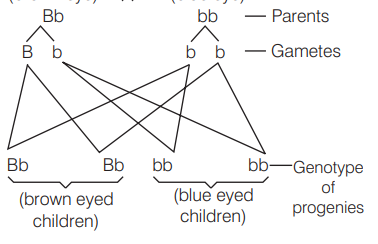
Question
Multiple alleles control inheritance of [CBSE AIPMT 1991]
(a) phenylketonuria
(b) colour blindness
(c) sickle-cell anaemia
(d) blood groups
Answer/Explanation
Ans. (d)
Multiple alleles control inheritance of blood groups in human. A, B, O blood group system is found in humans where the allele $I^A$ for $A$ antigen is codominant with the allele $I^B$ for the B antigen. Both $I^A$ and $I^B$ are completely dominant to the allele $I^O$. Hierarchy of dominance relationships is symbolised as $\left(I^A=I^B\right)>I^O$.
Question
Which contribute to the success of Mendel? [CBSE AIPMT 1988]
(a) Qualitative analysis of data
(b) Observation of distinct inherited traits
(c) His knowledge of Biology
(d) Consideration of one character at one time
Answer/Explanation
Ans. (d)
Mendel took one trait at a time for his experiments, this contributed a lot to his success.
